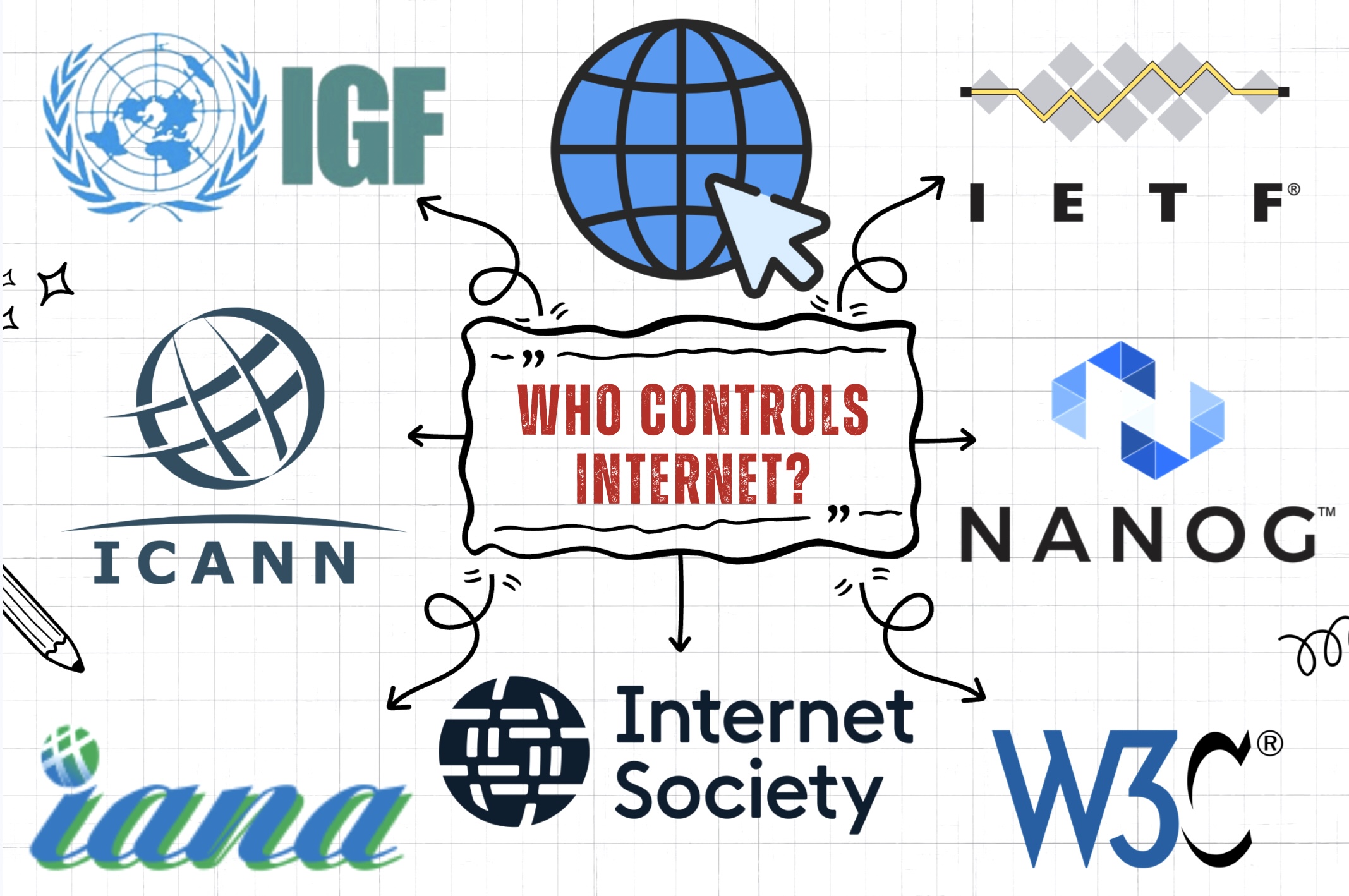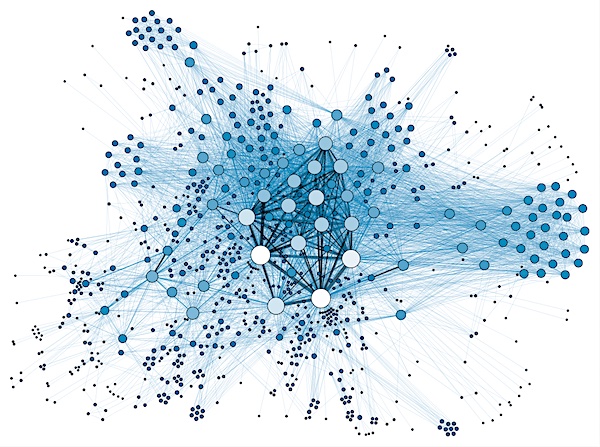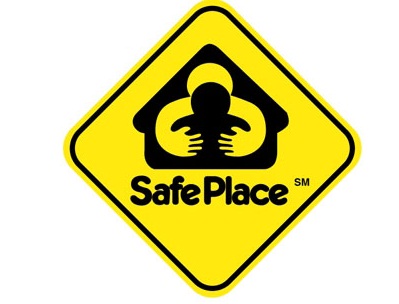The Internet is a huge “network of networks” that connects countless computer systems around the world. It has completely changed how we communicate and share information by making it easy for these networks to link and exchange data.
Originally invented in the 1970s, the Internet is now used by over 6 billion people, representing approximately 73% of the world’s population.
But who actually owns the Internet?
No one actually owns the internet: there is no single person, company, or government that owns the internet in its entirety. It’s more of a concept than a real, tangible entity, and it relies on a physical infrastructure that connects multiple computer networks.
The internet contains many different bits and pieces, each controlled by an organization. A few of these organizations can control the level of access the general public has to the Internet.
The following are the main organizations that play a crucial role in developing Internet technology, standards, infrastructure, and services. They do not own the entire system, but they can still affect your internet experience.

Table of Contents
1. Internet Engineering Task Force (IETF)
The IETF is an open community of network designers, operators, and researchers who develop and promote voluntary Internet standards that include the Internet protocol suite.
Although operations of IETF have changed a lot since its inception in 1986, the fundamental mechanism remains the same — publish proposed specifications, develop based on the proposals, individually test and review, and republish the revised proposal.
All IETF documents and standards are created in an open process and are freely available on the Internet. Anyone can access and modify them.
2. Internet Research Task Force (IRTF)
Unlike the IETF, which focuses on short-term issues in engineering standards development, the IRTF emphasizes long-term research on Internet architecture, protocols, applications, and technology.
It consists of a number of research groups, including the Decentralized Internet Infrastructure Research Group, the Quantum Internet Research Group, and the Privacy Enhancements and Assessments Research Group. They are all managed by the IRTF Chair in conjunction with the Internet Research Steering Group.
3. World Wide Web Consortium (W3C)
W3C is the international standards organization for the World Wide Web.
Led by Web inventor and director Tim Berners-Lee, the consortium develops web standards and software, engages in education and outreach, and serves as a forum for discussion about Web technologies. It also focuses on issues of accessibility, internationalization, and mobile web solutions.
W3C was founded in 1994. It now has 340 members, which include universities, nonprofit organizations, governmental entities, businesses, and individuals.
4. Number Resource Organization (NRO)
NRO is a coordinating body for the world’s Regional Internet Registries (RIRs). It has three main objectives:
- Protect the unallocated IP address resource pool
- Promote the multi-stakeholder model and bottom-up policy development process in Internet governance
- Coordinate and support joint activities of the RIRs
There are five RIRs in the world, which manage, distribute, and register Internet number resources (such as IP address space and Autonomous System Numbers) within their respective locations.
5. Internet Architecture Board (IAB)
IAB is a board of researchers and professionals that ensures the Internet continues to evolve as a platform for global communication and innovation. Its responsibilities include managing and publishing Request for Comments (RFC) and overseeing the Internet Standards Process and IETF activities.
In simple terms, the IAB works to
- Establish the technical direction for the Internet (its work helps billions of people stay connected and supports the long-term vision for the Internet of Things)
- Ensure that the Internet is a trusted medium of communication
- Facilitate the technical evolution of an open Internet with no special controls
6. Internet Assigned Numbers Authority (IANA)
 A view of Internet routing paths
A view of Internet routing paths
IANA coordinates some of the crucial elements that keep the internet running smoothly. Its activities can be categorized into three groups:
- Domain Names involve DNS root management
- Number Resources involves coordinating the global pool of IP and AS numbers
- Protocol Assignments involve managing Internet Protocols’ numbering systems
Regardless of the type of identifier (such as TCP, ICMP, or UDP), IANA ensures that each value is unique and available in publicly accessible registries to avoid confusion.
7. Internet Society (ISOC)

ISOC is a non-profit organization established in 1992. It provides leadership in Internet-related standards, access, education, and policy development.
ISOC offers forums for discussing issues affecting the development of the Internet. It also serves as a focal point for cooperative efforts to promote the Internet as a positive platform to benefit all users across the world.
8. Internet Corporation for Assigned Names and Numbers (ICANN)

ICANN is a non-profit organization composed of several groups, each representing a different Internet interest. They all contribute to ICANN’s final decisions.
Their role is to oversee the massive, complex, interconnected network of unique identifiers that allow devices on the network to recognize one another.
More specifically, ICANN oversees IP addresses, domain names, and the management of country-code top-level domains. It also promotes competition and develops policy on these unique identifiers.
9. North American Network Operators’ Group (NANOG)
Since 1987, NANOG has been committed to the ongoing advancement of an open and secure Internet. It organizes events, meetings, surveys, digital spaces, scholarships, and an influential mailing list for Internet service providers.
Their tri-annual meetings draw about 1,500 people in multiple facets of network architecture, operations, and engineering, who gather in major cities across North America. They discuss various topics, ranging from applications of new protocols to inter-provider security and routing scalability. All meetings are informal, and membership is open.
10. ISO 3166
ISO 3166 provides internationally recognized letter and number codes for countries, dependent territories, and special geographic regions. It is published by the International Organization for Standardization, an independent and non-governmental body.
ISO 3166-1 alpha-2 refers to two-letter country codes, used for the Internet’s country code top-level domains. For example, “au” is used for Australian domains and “f” for France.
11. Internet Governance Forum (IGF)
The IGF brings together all stakeholders (whether they represent the private sector, governments, or civil society) as equals to discuss public policy issues related to the Internet.
Although the IGF doesn’t directly modify the Internet standards, it informs and inspires those with policy-making power in both the private and public sectors. At annual meetings, stakeholders discuss the most efficient way to maximize internet opportunities while addressing associated risks and challenges.
Read: 8 Different Types Of Cloud Computing
Interesting Facts and Stats About the Internet
Google Searches Per Day
Although Google doesn’t share its search volume data, estimates suggest that the Google Search Engine alone processes over 180,000 search queries per second, totaling 5 trillion searches per year.
Total Number of Websites
There are about 1.1 billion websites, of which less than 200 million are active. By the time you finish reading this article, thousands of new websites will be created.
Data Created Every Day
About 402.7 million terabytes of data are created every day. This equates to 12 zettabytes per month and 147 zettabytes per year. More than half of all internet traffic comes from videos.
Read: 12 Largest Data Centers In The World [By Size]
Frequently Asked Questions
Who invented the Internet?
The invention of the Internet cannot be credited to a single person or a single organization. Instead, it took many pioneering scientists and engineers to develop new features and technologies that eventually merged to become the “Internet” we know today.
The first working prototype of the Internet was developed in the late 1960s with the formation of ARPANET. It used a technique called packet switching to enable several computing machines to communicate on a single network.
In 1983, ARPANET adopted TCP/IP, and from that point, scientists began working on the “densely interconnected network” that became the modern Internet.
In 1990, Tim Berners-Lee invented the World Wide Web, which quickly became the most common way to access data via hyperlinks and websites.
Read: Who Invented The Telephone? The Complete Truth
What is the Internet of Things (IoT)?
IoT refers to physical objects embedded with processors, sensors, software, and other technologies. These objects can connect and exchange data with other objects over the Internet.
Examples include smartphones, home security systems, fitness trackers, smart fire alarms, smart refrigerators, wearable health monitors, autonomous farming equipment, and various connected appliances.
According to a Statista report, the total installed base of IoT devices worldwide will reach 40.6 billion units by 2034.
How many people use the internet?
There are roughly 6 billion active internet users worldwide, about 73% of the global population. Of them, around 5.66 billion people (68.7% of the world’s population) use social media.
Saudi Arabia, the UAE, Denmark, Norway, Luxembourg, and Sweden have the highest internet penetration rates. North Korea, on the other hand, has virtually no online usage penetration among the public.
How much energy does the internet use?
The Internet and its infrastructure (including data centers and user devices) use about 4% to 6% of the world’s electricity, with some estimates suggesting even more. This share could rise to 20% by 2030.
Servers and cooling systems in large data centers account for the largest share of direct electricity consumption, followed by storage drives and network equipment. The largest data centers worldwide consume as much as 100 megawatts of power, enough to power about 80,000 US households.
Read More


